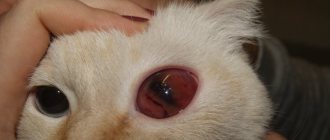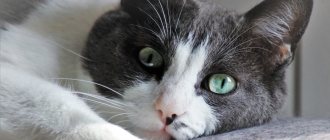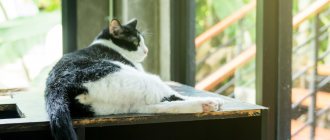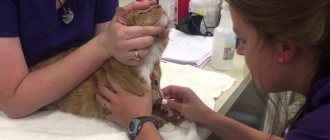Origin story
Likoi, a breed of werewolf-like cats, has appeared quite recently. Most often, they name 2010, when breeders in the United States had a litter of very strange-looking kittens. This turned out to be the result of crossing domestic cats and sphinxes. As a result, breeder Patti Thomas wanted to get more rounded and massive Sphynx cats, so she initially identified the kittens as non-viable and sick.
She decided to start by showing the babies to Sphynx breeders, the Gobble spouses. After careful examination, the researchers identified a rare mutation in the genotype, which led to this effect. Felinologists deliberately obtained another litter of unattractive kittens and examined them.
It turned out that the werewolf cat has good health from a young age. The gene that is responsible for the appearance of cat demons affects the hair follicles, almost completely depriving the animal of hair during the molting period.
This section of DNA is recessive, so it may not appear in some babies. In addition, the Lykoi werewolf cat does not have an undercoat, and the guard hairs are not thick. For further selection, kittens from the first and second litters and ordinary domestic cats were used.
The breed was recognized in its homeland already in 2012, but in the world community they are recognized with the mark “representatives of a new developing breed.”
What does a yokai look like?
Kasi appears before readers in the form of a large cat with a human body and a fiery tail. Powerful paws with claws and hellish fire make the demon terrifying. With the help of a storm or typhoon, he carries sinful people to hell.
When writing the name using hieroglyphs, the word Kasi is deciphered as “carts on fire.” When Toriyan came up with the image of the spirit of the underworld, he wanted to combine the image of a cat youkai and a burning cart, symbolizing the gates to hell. However, the deep roots of the history of Japanese perfumes say that Kashi looked very different.
The image of the demon was depicted on an ancient scroll that belongs to Sawaki Suushi. This image is almost 60 years older than Toriyama's illustration. Sawaki portrayed Kashi as a man with hellfire. However, Toriyama decided to flesh out the demon into an animal, creating a completely new spirit.
Now an illustration of the demon Kasi can be seen in the form of a cat engulfed in flames.
Description of appearance
Werecats have an expressive and unusual appearance. Since the breed is new, there is no regulated standard yet, but the characteristic features of the Lykoi cat are extremely accurate.
Werewolves of the cat breed are of medium size in build and dimensions are similar to the Canadian Sphynx. The body of the Lykoi is elongated and lean, with a pronounced muscular structure and medium-sized bones. Surprisingly, a genetic test showed that the animals are a type of short-haired domestic cat, and not hairless pets.
A distinctive feature of the Lykoi breed is its coat. The specific absence of down and rather sparse guard hairs look as if the cat has some kind of dermatological disease. Since the fur on the face is completely absent, forming a mask, the resemblance to a werewolf at the moment of transformation is quite realistic.
The standard coat color of a roan cat is black with sparse gray hairs. This color is typical only for horses. Dogs also have black coats with graying, so adults look quite distinctive. The optimal ratio for cat demons between black and blond hairs is 50/50.
Cats have an elongated wedge-shaped head, the nose has a distinct hump. The eyes are large, round, very expressive. Representatives of the Lykoi breed can have any eye color, including gray; the optimal color is gold. The Lykoi cat has large ears located at right angles to the head, the tips are pointed, and the base is wide.
Description of the Lykoy cat breed
Likoi is a cat that manages to combine the characteristics of an affectionate domestic cat and a fantastic creature from a parallel universe. It is not for nothing that such cats are called werewolves, devil or demon cats, and Lycon cats.
What does a cat of this breed look like?
History of origin
The Lykoi breed is new, it appeared only in 2010, completely by accident, in the USA as a result of crossing a beautiful lady, an American shorthair cat, and a Sphynx cat, who unwittingly became the father of this breed. Sociologists hoped to get a bald, like a sphinx, but strong cat with a rounded physique. But the result surprised scientists. Kittens were born, partially covered with short hair. Experts decided that these strange creatures would not live long, but they began to grow and develop like ordinary healthy kittens.
For your information! The result of the research showed that the animals are completely normal, and their appearance is the result of a natural mutation. It turned out that they have no genetic connection with sphinxes and other cats without hair. They inherited the entire set of chromosomes from their shorthaired parents. After hesitating a little, the breeders finally decided to breed them and, after just two years, the Lykoi cat became an officially registered breed.
Cats that look like werewolves, or a demon cat
In their appearance, Lykoi cats are similar to werewolves from science fiction films or cartoons, where there are certainly mysterious Gothic haunted castles. Everyone passing by will definitely turn their attention to such an animal. It is almost impossible to describe in words the appearance of the demon cat breed. To understand what we are talking about, you need to see everything with your own eyes. Their muzzle is almost bald, elongated, somewhat reminiscent of a wolf. The large, intelligent eyes of a predator and huge ears clearly stand out on it. The body is long, elongated, resembling the body of a sphinx.
Character traits
The devil cat has a wonderful character and high intelligence. Such a pet is very attached to a person and shows miracles of obedience at the right moments. Lykoi cats calmly experience forced loneliness, but will happily play in the company of other animals.
The Lykoi cat is a very friendly animal towards its owners. After going through a period of adaptation, these animals become attached to their owners almost like dogs.
Lykoi cats are wary of unfamiliar people and animals, and if danger is visible, they are capable of attacking a potential offender. However, having gotten to know him better, they may well show their affection. In some cases, a cat may rush at a dog or a stranger who, in his opinion, is threatening his beloved owner.
These amazing animals have a highly developed hunting instinct, so you should not house them with rodents or fish. It is better to purchase an interactive toy with which the pet will enthusiastically spend his free time from the owner.
Health
The health of representatives of the Lykoy breed is quite good; at the moment, no pathologies characteristic of this breed have been identified. However, felinologists warn that the werewolf cat has not yet been studied enough to predict possible diseases.
Lykoi can be susceptible to a variety of infections and diseases that are common to all felines. Therefore, you should not rely on the natural reserves of your pet’s body and carefully care for it and take it to the doctor.
Maintenance and care
The Lykoi cat breed is easy to care for. Keeping animals with sparse hair requires regular cleaning of bare areas with wet wipes, as they sweat quite a lot. It is recommended to wash such pets, but they really do not like to bathe.
It is worth cleaning werewolves' ears and caring for their claws weekly. You should also examine your eyes daily and, if necessary, clean them of dirt with a clean napkin.
Feeding
The Lykoi cat has an excellent appetite. Such pets, due to the small amount of wool, need a fairly large amount of food. You should carefully consider their diet and not overfeed them to avoid excessive weight gain.
It is optimal to feed Lykoya several times a day in small portions of industrial high-quality food. The animal must have a nutritious diet and receive enough nutrients, vitamins and minerals.
Description of bakeneko
The Japanese believed that if a cat lived more than 13 years, it could become a bakeneko. A cat weighing 1 kan (3.75 kg) could also become a youkai.
The reason why there are many cat youkai in Japanese mythology is due to the characteristics they possess. Examples include the way their irises change shape depending on the time of day, and the way their fur generates sparks due to static electricity when petted (especially in winter).
It is also noteworthy how they sometimes lick their wounds and how they can move silently. Cats belong to the wild, despite the gentleness they sometimes exhibit in behavior. They are more difficult to train (unlike dogs). Their claws and teeth are sharp.
Their nocturnal habits, as well as their speed and agility, deserve attention. In ancient Japanese tales, there are many yōkai animals that are different from cats but have similar properties: the agility of snakes, the ability of foxes (kitsune) to transform into women, the cruelty of tanuki towards people depicted in the folk tale Kati-kachi Yama from the Edo period.
Cats have a lot of rumors and superstitions surrounding them, thanks to the unique position they occupy between nature and civilization. When cities and towns were founded, and people began to live away from nature, cats accompanied them. Because they lived close to people but retained their wild nature and air of mystery, stories were written about them. This is how the image of bakeneko gradually formed.
How much does a Lykoi cat cost?
At the moment, there are less than a dozen registered breeders of the Lykoi cat breed. Therefore, the cost of representatives of the Lykoi breed is quite high, and the cost of delivering the baby to the owner will also be added to it. A kitten of the Lykoi breed can be bought for 160 thousand rubles in a trusted nursery. For a baby of a non-standard blue color you will have to pay half as much - 80 thousand rubles.
Purchasing a kitten
To purchase a Lykoya you will have to come to the USA, and first wait your turn and prove your worth as an owner. Lykoi kittens are not too different from adult animals. Most often, they are born completely black, and only after the first molt they acquire a standard color.
Lykoi is an exotic and non-standard cat breed that is gaining more and more fans. You can fall in love with Likoev at first sight, because with their unique appearance they have the ideal character of a four-legged friend and loyal comrade-in-arms.
Greasy tail in a cat: causes and treatment (photo)
The fat on a cat's tail can be washed off. For this purpose, a remedy for greasy cat tails is selected in the form of paste, powder and sprays. But it is better to use a special shampoo: shampoos marked “for greasy hair”, “against seborrhea”, “for seborrheic dermatitis”, etc. help against a cat’s greasy tail.
If you don’t have cat shampoos at home and you urgently need to wash off the fat, you can use a specialized product for people aimed at solving a similar problem. But only premium or professional, not mass market. For example, Vishi shampoo against seborrheic dermatitis is good because, in addition to drying substances, it also contains moisturizing components: after washing with products based only on drying substances, the skin becomes overdried and additionally needs moisturizing, but Vishi does everything itself. Of course, if possible, use a special cat shampoo on a regular basis.
In two soapings, the tail is washed off perfectly: no fat or greasy crusts remain on the skin.
If suddenly after washing there are areas with greasy crusts and dirt, and also in order to prevent the addition of a bacterial infection, the remaining grease and dirt can be additionally removed using a cotton pad moistened with a solution of chlorhexidine digluconate.
Some owners try to wash off the fatty base of the cat's tail using Fairy. Surprisingly, similar advice can be heard from veterinarians and felinologists. Indeed, “Fairy” washes the tail well, until it squeaks. But you still don't need to use it. Fairy and other dishwashing detergents disrupt skin pH and microflora, and also lead to other problems.
How to wash a cat's greasy tail if he is afraid to swim? Firstly, being afraid of bathing does not mean that the animal cannot be washed. Many people are afraid - not many people fight to the death in the bathroom. If the cat does not go into a crazy state at the sight of water, it is quite possible to wash it by force. Secondly, if this task is really difficult or there is nothing suitable for washing at hand, you can use ordinary potato starch: it absorbs fat well. Apply starch liberally to the skin and fur of the tail, rub, wait a little so that the fat has time to be absorbed, and comb out the starch with a comb.
Starch and special dry shampoos can be used every day or as fat accumulates. But washing a cat’s tail under water every day is not recommended, so as not to dry out the skin and get the opposite effect - even greater activity of the sebaceous glands. However, you will now have to wash your tail often to prevent the consequences of such an unpleasant condition. This is done as oil and dirt accumulate on the skin.











